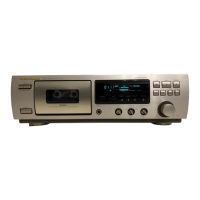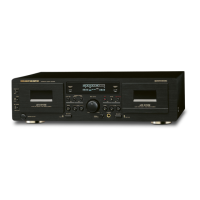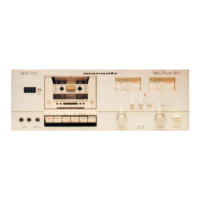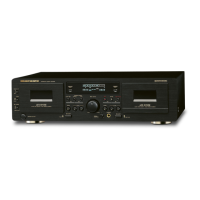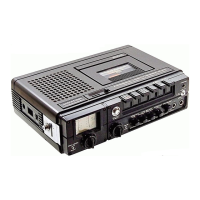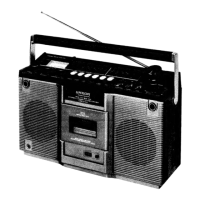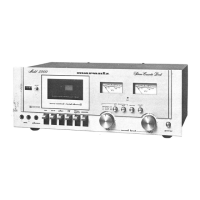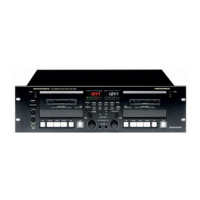Do you have a question about the Marantz SD-60 and is the answer not in the manual?
Essential safety warnings regarding operation, handling, and electrical precautions.
Information on voltage settings and compliance for different Marantz product versions.
Details on wiring colors and fuse ratings for UK power plugs.
General precautions for operating the equipment safely and maintaining performance.
Connect to amplifier tape input/output jacks for audio signal transfer.
Connect for system remote control operation with compatible components.
Connect the AC line cord into an AC outlet providing the proper voltage.
Controls for turning the unit on/off and setting timer-activated playback/recording.
Eject button, cassette loading indicator, and anti-record indicator.
Buttons for Quick Music Search, Auto Music Scan, Blank Skip, and display functions.
Indicators for recording, peak levels, tape/source, HX PRO, Dolby NR, and MPX-F.
REC button for pause mode, REC MUTE for creating gaps.
Buttons for fast rewind, pause/resume, and fast forward.
Starting playback, repeating selections, and stopping the deck.
MPX-F switch for FM broadcasts; Dolby B/C NR for hiss reduction.
Adjusting recording level and bias for optimal sound quality.
Calibrating recording levels and balancing channels for accurate sound.
Switching between source and tape sound for monitoring during recording/playback.
Using memory buttons, counter reset, and mode selection for tape management.
Loading tape, selecting playback, and using Quick Music Search.
Steps for loading tape, setting NR/HX PRO, adjusting levels, and starting recording.
Functions for quick rewind and automatically creating silent gaps.
Explanation of Dolby B and C noise reduction for reduced tape hiss.
Guidelines for setting recording levels to avoid distortion and preserve dynamics.
Instructions for cleaning heads, guides, pinch roller, and tape path.
Automatic setting of bias and equalizer based on cassette type.
Recommendations for tape types and brands for optimal recording quality.
Method to prevent accidental erasure of recordings using safety tabs.
How to adjust bias for flat frequency response with different tapes.
Instructions for cleaning the exterior surfaces of the Marantz unit.
Guidance on who should service the equipment and how to get repairs.
Troubleshooting steps for common malfunctions, including power cycling.
Essential safety warnings regarding operation, handling, and electrical precautions.
Information on voltage settings and compliance for different Marantz product versions.
Details on wiring colors and fuse ratings for UK power plugs.
General precautions for operating the equipment safely and maintaining performance.
Connect to amplifier tape input/output jacks for audio signal transfer.
Connect for system remote control operation with compatible components.
Connect the AC line cord into an AC outlet providing the proper voltage.
Controls for turning the unit on/off and setting timer-activated playback/recording.
Eject button, cassette loading indicator, and anti-record indicator.
Buttons for Quick Music Search, Auto Music Scan, Blank Skip, and display functions.
Indicators for recording, peak levels, tape/source, HX PRO, Dolby NR, and MPX-F.
REC button for pause mode, REC MUTE for creating gaps.
Buttons for fast rewind, pause/resume, and fast forward.
Starting playback, repeating selections, and stopping the deck.
MPX-F switch for FM broadcasts; Dolby B/C NR for hiss reduction.
Adjusting recording level and bias for optimal sound quality.
Calibrating recording levels and balancing channels for accurate sound.
Switching between source and tape sound for monitoring during recording/playback.
Using memory buttons, counter reset, and mode selection for tape management.
Loading tape, selecting playback, and using Quick Music Search.
Steps for loading tape, setting NR/HX PRO, adjusting levels, and starting recording.
Functions for quick rewind and automatically creating silent gaps.
Explanation of Dolby B and C noise reduction for reduced tape hiss.
Guidelines for setting recording levels to avoid distortion and preserve dynamics.
Instructions for cleaning heads, guides, pinch roller, and tape path.
Automatic setting of bias and equalizer based on cassette type.
Recommendations for tape types and brands for optimal recording quality.
Method to prevent accidental erasure of recordings using safety tabs.
How to adjust bias for flat frequency response with different tapes.
Instructions for cleaning the exterior surfaces of the Marantz unit.
Guidance on who should service the equipment and how to get repairs.
Troubleshooting steps for common malfunctions, including power cycling.
| Type | Stereo Cassette Deck |
|---|---|
| Track System | 4-track, 2-channel stereo |
| Heads | 1 x record/playback, 1 x erase |
| Tape Type | type I, CrO2, Metal |
| Total Harmonic Distortion | 1.0% |
| Input | 70mV (line) |
| Motor | DC servo motor |
| Wow and Flutter | 0.05% |
| Inputs | Line in |
| Outputs | Line out |
